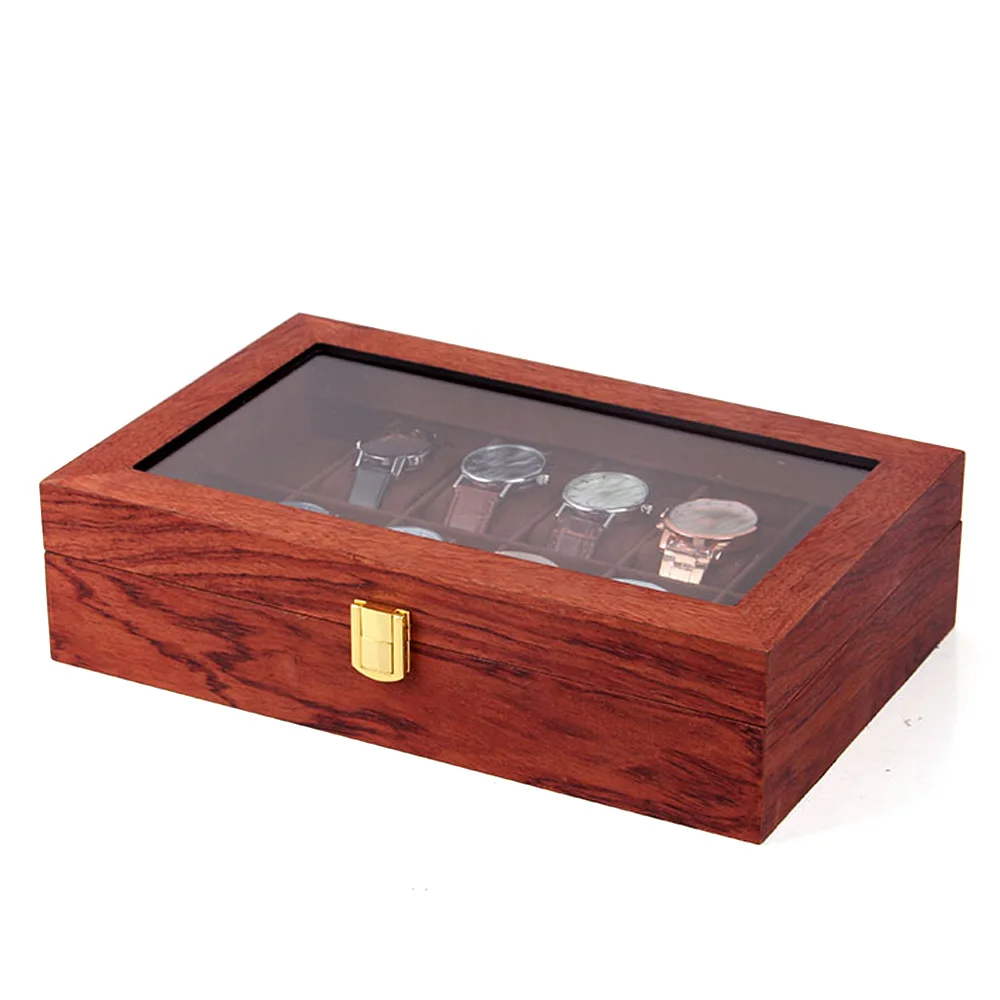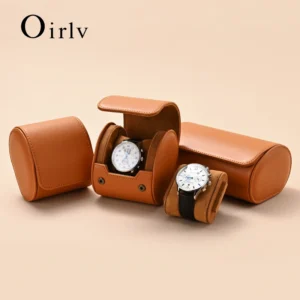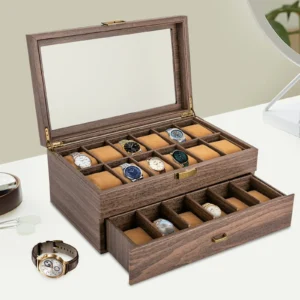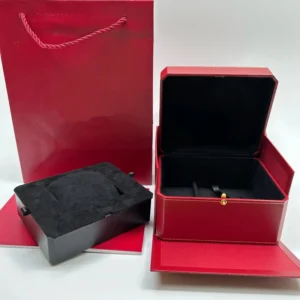Introduction
A quality watch deserves proper storage that not only protects it from damage but also showcases its beauty. For collectors and enthusiasts alike, the right watch box serves as both a functional storage solution and an extension of their appreciation for fine craftsmanship. When exploring premium watch storage options, two materials consistently stand out: wood and leather.
These classic materials have long been the gold standards for watch boxes, each bringing distinctive qualities to the table. Wood offers timeless elegance and solid protection, while leather provides sophisticated flexibility and modern appeal. Your choice between them will depend on several key factors: the level of protection you need, aesthetic preferences, durability requirements, and maintenance considerations.
At Daily Accents, we understand that proper storage does more than just house your timepieces—it prevents scratching, protects against dust accumulation, and significantly extends the lifespan of your watches. The right watch box becomes an essential companion to your collection, reflecting the care and attention you invest in your timepieces.
As we explore the differences between wood and leather watch storage, we’ll help you navigate the features, benefits, and considerations of each option to find the perfect home for your valued watches.
Understanding Watch Box Materials: Why Material Matters
The material of your watch box isn’t merely an aesthetic choice—it fundamentally influences how well your timepieces are protected and preserved over time. The exterior material creates the first line of defense against environmental factors that could potentially damage your valuable collection.
Quality watch boxes combine thoughtful material selection with careful construction to create optimal storage conditions. Beyond just the outer shell, a truly excellent watch box considers:
- Structural integrity – How well the box maintains its shape and protects contents from physical damage
- Environmental protection – The material’s ability to shield watches from dust, humidity, and light exposure
- Interior compatibility – How the exterior material works with interior linings to prevent scratches
- Weight and durability – The balance between sturdiness and practical usability
- Aging characteristics – How the material develops patina or shows wear over time
Historically, wooden boxes have been the traditional choice for watch storage, dating back to when watchmakers delivered their creations in handcrafted wooden presentation cases. Leather options emerged more recently as a lightweight alternative that offers different aesthetic and functional properties.
When comparing these materials, it’s important to consider both your practical needs and personal preferences. The detailed comparison of materials reveals that neither option is universally superior—each excels in different areas and appeals to different collector priorities. Before making a choice, exploring our varied watch box options can help you visualize the differences.
Wood Watch Boxes: Classic Elegance and Protection
There’s something inherently luxurious about a finely crafted wooden watch box. The natural warmth and character of wood create a distinguished presentation that feels both substantial and refined. Wooden watch boxes convey a sense of permanence and tradition that complements the timeless nature of fine watchmaking.
The craftsmanship involved in creating quality wooden watch boxes is evident in the precision joinery, hand-finished surfaces, and attention to detail. From the satisfying weight when you lift the lid to the subtle aroma of natural wood, these boxes engage the senses in a way that manufactured materials simply cannot match.
Wood watch boxes are available in a stunning variety of finishes and grain patterns. From the rich, dark elegance of walnut to the warm honey tones of cherry, each wood type brings its own distinctive character to your watch storage. Many collectors choose wood that complements their home furnishings or matches other wooden elements in their personal space.
The association between wooden cases and luxury goods has deep historical roots. Fine watches, jewelry, and other precious items have traditionally been presented and stored in wooden containers, creating a psychological connection between wood and items of value. This traditional luxury appeal makes wooden watch boxes particularly fitting for vintage timepiece collections or classic watch brands.
Perhaps most importantly, wood provides a complementary backdrop for showcasing your timepieces. The natural contrast between organic wood grain and the metallic elements of watches creates a visually striking presentation that draws attention to your collection. For those interested in exploring this classic option further, our guide to the benefits of wooden watch storage provides additional insights, or you can browse our wooden watch box collection for inspiration.
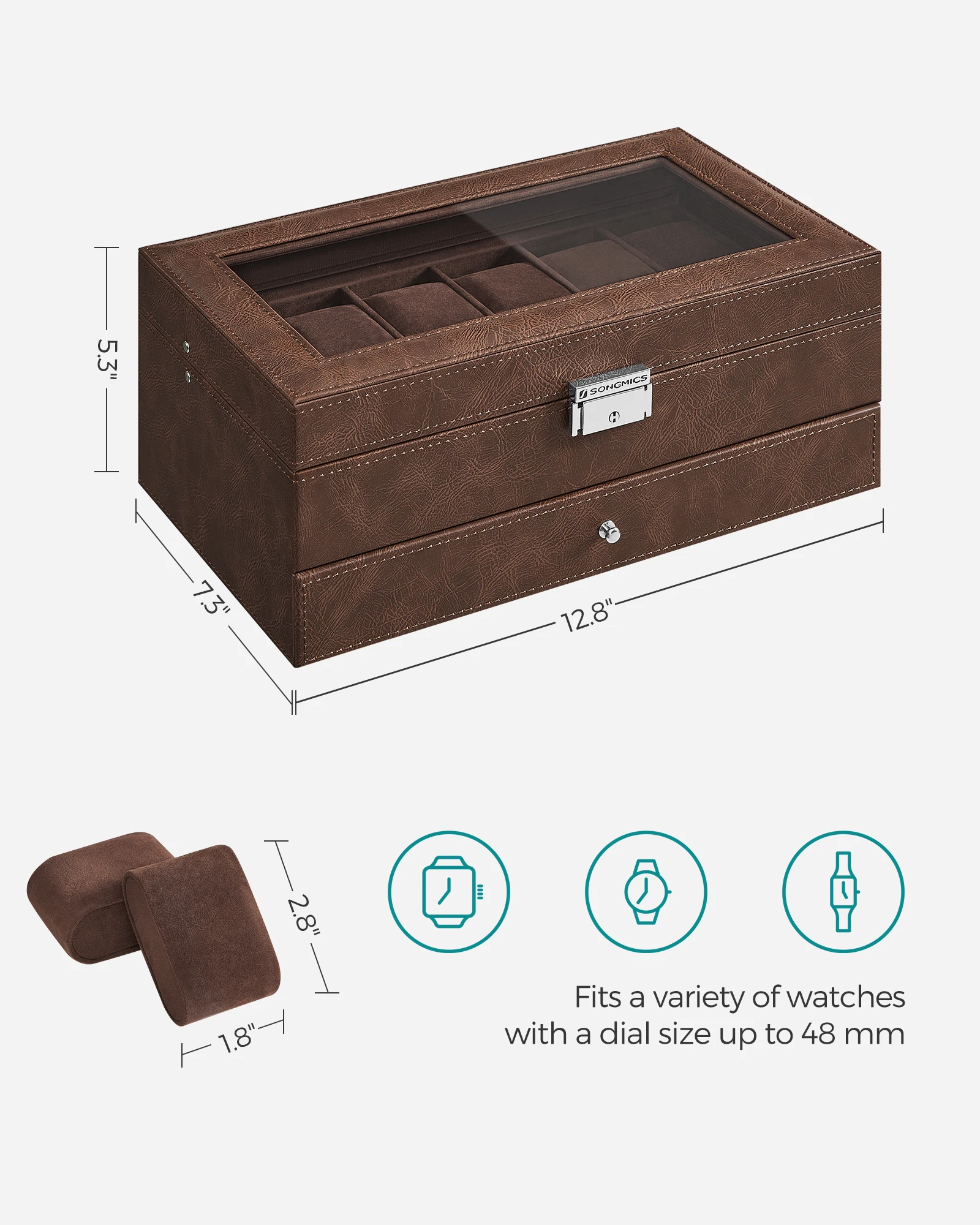
Benefits of Wood Watch Boxes
Wood watch boxes offer several distinct advantages that have made them the preferred choice for many serious collectors:
- Superior structural integrity – Wooden boxes provide exceptional protection against physical impacts, with solid construction that shields watches from accidental bumps or drops.
- Natural climate regulation – Quality hardwoods have inherent properties that help buffer against sudden temperature changes, creating a more stable environment for sensitive watch mechanisms.
- Effective dust protection – Well-crafted wooden boxes with proper sealing keep dust particles away from your watches, preventing accumulation on dials and between bracelet links.
- Aesthetic versatility – From traditional to contemporary designs, wooden watch boxes complement virtually any interior style.
- Visual personalization – Different wood species and finishes allow for customization that matches your personal aesthetic preferences.
- Premium display options – Many wooden boxes feature glass viewing tops that transform storage into an elegant display.
- Substantial presence – The weight and solidity of wooden boxes convey quality and permanence.
The natural insulation properties of wood deserve special mention. Unlike synthetic materials that quickly respond to external temperature fluctuations, wood creates a more gradual temperature transition inside the box. This characteristic is particularly valuable for mechanical watches, where sudden temperature changes can potentially affect timing accuracy.
Quality wooden watch boxes typically feature excellent joinery techniques that enhance both durability and appearance. Dovetail corners, precisely fitted hinges, and smooth-operating latches demonstrate the craftsmanship that goes into premium storage solutions. These construction details contribute to the box’s ability to protect your collection over many years.
For collectors who value presentation as much as protection, wooden boxes with glass display tops offer the perfect combination. These designs allow you to admire your collection at a glance while keeping watches secure and dust-free. The best wood watch boxes achieve an ideal balance between showcasing your timepieces and protecting them from environmental factors.
Popular Wood Types for Watch Boxes
Different wood species bring unique characteristics to watch boxes, affecting both appearance and performance. Here’s a breakdown of the most common woods used in premium watch storage:
| Wood Type | Appearance | Characteristics | Best For |
|---|---|---|---|
| Walnut | Rich chocolate brown with straight to wavy grain | Dense, shock-resistant, minimal shrinkage | Collectors seeking sophistication and durability |
| Oak | Light to medium brown with prominent grain patterns | Extremely strong, resistant to warping, distinctive texture | Traditional styles and high-durability needs |
| Mahogany | Reddish-brown that deepens over time | Stable, resistant to swelling, historical luxury association | Classic watch collections with vintage appeal |
| Cherry | Smooth, reddish-brown that darkens with age | Straight grain, develops rich patina over time | Warm, inviting presentation that improves with age |
| Maple | Pale cream to light reddish-brown | Hard, resistant to abrasion, clean appearance | Modern spaces and minimalist aesthetics |
| Exotic Woods | Varied (often with distinctive figuring) | Unique appearance, often featuring unusual grain patterns | Statement pieces and ultra-premium collections |
Walnut remains one of the most popular choices for luxury watch boxes due to its perfect balance of beauty and functionality. Its rich color provides an elegant backdrop for watches of any style, while its natural density offers excellent protection. The color stability of walnut means it maintains its appearance without dramatic changes over time.
Oak’s prominent grain pattern creates a more traditional, distinctive look. Its exceptional strength makes it ideal for larger display cases or boxes that will see frequent handling. Oak watch boxes often feature quarter-sawn cuts that showcase the wood’s medullary rays—beautiful flecks that run perpendicular to the grain.
Cherry wood begins with a lighter appearance but develops a rich, deep patina over years of exposure to light. This aging process makes cherry watch boxes particularly special, as they develop character and warmth over time, much like a well-loved watch collection itself.
For those seeking specific styles or sizes, our 6-watch box options showcase how different woods can be crafted into practical storage solutions for growing collections.
Drawbacks of Wood Watch Boxes
Despite their many benefits, wooden watch boxes do have some limitations to consider:
- Weight and bulk – Wooden boxes are typically heavier and less portable than leather alternatives, making them less ideal for travel or frequent relocation.
- Susceptibility to surface damage – Without proper care, wood can develop scratches and dents from everyday handling.
- Regular maintenance requirements – Different finishes require specific care routines to maintain their appearance and protective qualities.
- Humidity sensitivity – In extremely dry or humid environments, wood can potentially crack, warp, or swell without proper climate control.
- Higher price point – Quality craftsmanship and premium materials generally command higher prices than simpler storage options.
- Less adaptability – Once constructed, wooden boxes cannot be reshaped or reconfigured like some softer material options.
The maintenance needs of wooden watch boxes shouldn’t be overlooked. Depending on the finish, they may require regular dusting with a soft cloth, occasional treatment with appropriate wood products, and placement away from direct sunlight to prevent fading or drying. Some finishes are more forgiving than others—lacquered surfaces typically require less maintenance than oiled finishes, which may need periodic reapplication to maintain protection.
Environmental conditions can significantly impact wooden watch boxes. Extremely dry conditions may cause wood to contract and potentially crack, while excessive humidity might lead to swelling or warping. This sensitivity makes wooden boxes somewhat less ideal for regions with dramatic seasonal humidity changes unless your home maintains relatively stable climate control.
For a deeper understanding of potential challenges, our article on disadvantages of wooden watches explores these considerations in greater detail. However, many collectors find that the benefits of wooden storage far outweigh these potential drawbacks when proper care is taken.
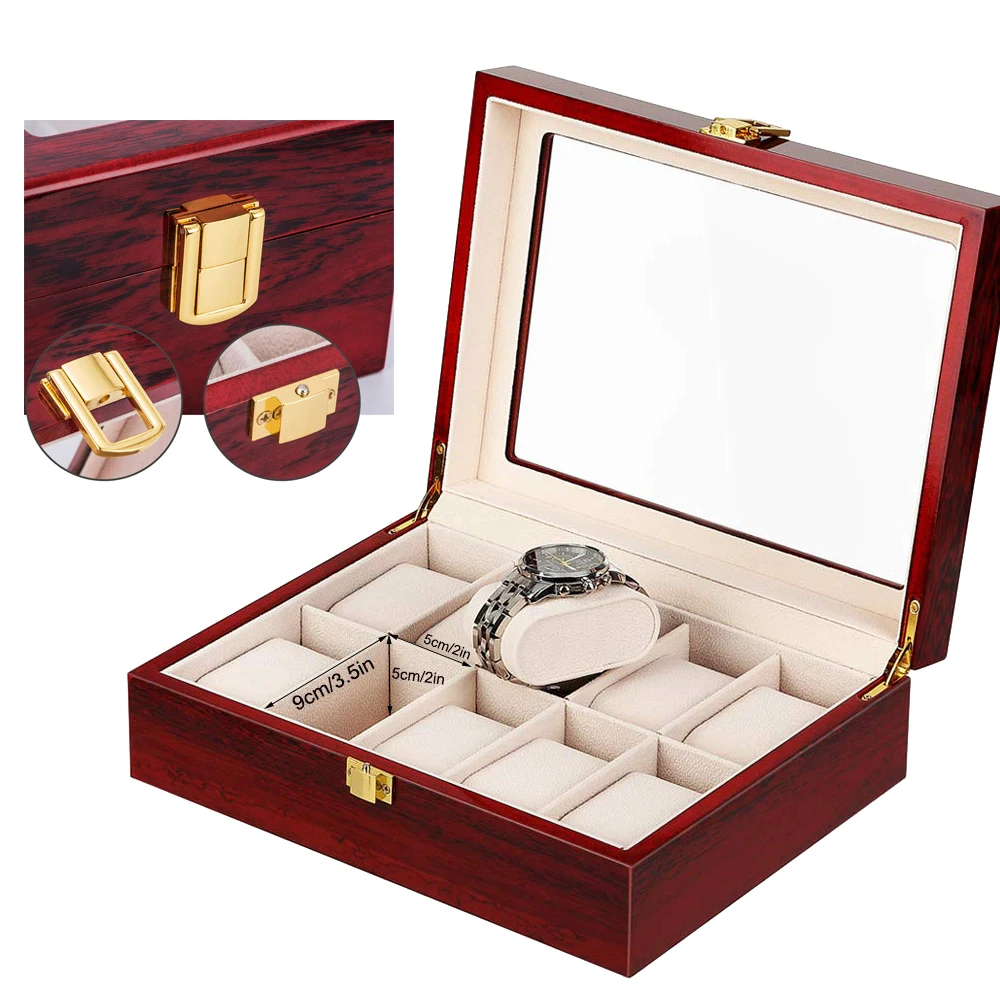
Leather Watch Boxes: Modern Sophistication
Leather watch boxes represent a more contemporary approach to timepiece storage, offering a sleek sophistication that appeals to modern collectors. The soft, supple nature of leather creates an immediate sense of luxury that feels both refined and approachable.
The tactile experience of a leather watch box adds another dimension to your collection. From the subtle grain texture beneath your fingertips to the gentle flexibility as you open the lid, leather engages your sense of touch in a way that’s distinctly different from the rigid structure of wood. This sensory quality makes accessing your watches a more intimate experience.
Leather watch boxes are available in a spectrum of colors and finishes that extend far beyond the natural wood palette. From classic black and rich brown to bold blues and vibrant reds, leather offers creative freedom to match your personal style or complement your watch collection’s aesthetic. The variety of textures—from smooth and polished to pebbled or embossed—further expands your options.
The modern luxury association with leather accessories makes these boxes particularly well-suited to contemporary watch collections. Sleek, minimalist designs in fine leather create a sophisticated presentation that feels current and fashion-forward. The material creates an interesting contrast with metal watch elements, allowing the mechanical beauty of your timepieces to stand out.
For those interested in exploring the distinctive qualities of this material, our guide to premium leather watch box features offers additional insights. You can also browse our leather watch box collection to see how this versatile material has been incorporated into various storage designs.
Benefits of Leather Watch Boxes
Leather watch boxes offer several unique advantages that make them increasingly popular choices for collectors:
- Excellent portability – The lightweight nature of leather makes these boxes ideal for transport, perfect for collectors who travel with their timepieces.
- Gentle watch contact – Soft leather exteriors and typically plush interiors offer gentle protection against scratches and abrasions.
- Contemporary aesthetic – Modern, sleek designs complement contemporary decor and newer watch styles.
- Design versatility – Leather can be crafted into a wide range of styles from minimalist to ornately detailed.
- Simplified maintenance – Many leather finishes can be easily wiped clean with appropriate products.
- Space efficiency – Leather boxes are often designed with slimmer profiles than wooden alternatives, saving valuable desk or dresser space.
- Accessible pricing – Quality leather options are often available at more moderate price points than comparable wooden boxes.
The travel-friendly nature of leather watch boxes deserves special attention. Their lighter weight makes them significantly more practical for frequent travelers. Many leather watch cases are specifically designed with travel in mind, featuring secure closures, compact dimensions, and protective interiors that keep watches safe during transit. For collectors who routinely travel with multiple timepieces, these travel options for watch storage provide practical solutions without sacrificing style.
Leather watch boxes also excel in their ability to protect watch finishes. The naturally soft material is less likely to cause accidental scratching if a watch shifts position during storage or removal. This gentle touch makes leather particularly suitable for storing watches with highly polished cases or delicate finishes that show marks easily.
The aesthetic flexibility of leather allows for greater personalization and style matching. Whether you prefer the understated elegance of black leather with minimal stitching or the rich character of distressed brown leather with decorative elements, there’s likely a design that perfectly complements your taste and collection style.

Types of Leather Used in Watch Boxes
Not all leather is created equal, and the type used in your watch box significantly affects both its appearance and longevity. Here’s a comparison of common leather types found in quality watch boxes:
| Leather Type | Appearance | Durability | Characteristics | Price Point |
|---|---|---|---|---|
| Full-grain | Natural texture with visible pores and markings | Excellent | Develops unique patina, strongest layer, most breathable | Premium |
| Top-grain | Smooth, consistent surface with subtle natural character | Very Good | Balance of refinement and durability, thinner but strong | High |
| Genuine Leather | Varied appearance depending on finishing techniques | Good | Often corrected surface, less breathable, adequate protection | Moderate |
| PU/Faux Leather | Uniform appearance with consistent color | Fair | Man-made alternative, no natural variations, vegan-friendly option | Budget-Friendly |
Full-grain leather represents the highest quality option, using the uppermost layer of the hide with all natural grain intact. This premium material develops a beautiful patina over time, with each box evolving a unique character based on use and exposure. While initially more expensive, full-grain leather often ages more beautifully than other types and offers superior longevity.
Top-grain leather strikes a balance between luxury and practicality. By lightly sanding the surface and applying a finish, manufacturers create a more uniform appearance while retaining good durability. This type of leather offers excellent quality at a somewhat more accessible price point than full-grain options.
Genuine leather (sometimes called split leather) uses lower layers of the hide and typically undergoes more processing to achieve a consistent appearance. While still a natural material, it lacks the strength and character development of higher-grade leathers but provides adequate protection at a more moderate cost.
For those with ethical concerns about animal products, PU (polyurethane) or faux leather alternatives offer animal-free options that mimic the appearance of leather. While typically less durable than genuine leather, these materials have improved significantly in recent years and can provide attractive, functional storage solutions.
The finishing process also dramatically affects leather’s appearance and performance. From glossy, polished finishes to matte, pebbled textures, these treatments influence both aesthetic appeal and resistance to wear. Our luxury watch box options showcase how different leather types and finishes can create distinctive storage solutions.
Drawbacks of Leather Watch Boxes
While leather watch boxes offer many advantages, they do have some limitations to consider:
- Limited impact resistance – Leather provides less structural protection against heavy impacts or crushing pressure than rigid wood boxes.
- Surface vulnerability – Leather can develop scuffs, scratches, and color changes with regular handling and exposure to light.
- Conditioning requirements – Quality leather needs periodic conditioning to prevent drying, cracking, and maintain suppleness.
- Quality variations – The performance gap between premium and lower-grade leather can be substantial, affecting longevity.
- Potential odor – Some leather finishes may have a distinct smell, especially when new, which could transfer to watches if not properly ventilated.
- Temperature sensitivity – Leather offers less insulation against temperature fluctuations than thicker wooden options.
The varying quality of leather products poses a particular challenge when selecting a watch box. The difference between top-quality full-grain leather and lower-grade options isn’t always immediately apparent but becomes evident over time through wear patterns and aging characteristics. This makes research and purchasing from reputable sources especially important.
Leather requires specific care to maintain its appearance and protective qualities. Regular conditioning with appropriate leather products helps prevent drying and cracking, particularly in low-humidity environments. Without proper maintenance, leather can become brittle, losing both its attractive appearance and protective flexibility.
Environmental factors can significantly impact leather watch boxes. Direct sunlight may cause fading or color changes over time, while excessive dryness can lead to cracking. Conversely, high humidity environments may encourage mold growth if the leather isn’t properly treated and ventilated.
Understanding proper leather watch case maintenance can help mitigate these concerns and extend the life of your storage solution while keeping your watches in optimal condition.
Interior Considerations: What Touches Your Timepieces
While the exterior material often receives the most attention, the interior lining of your watch box is equally important—perhaps even more so, as it directly contacts your timepieces. Regardless of whether you choose wood or leather for the exterior, the interior quality will significantly impact how well your watches are protected.
Quality watch boxes typically feature soft, non-abrasive linings that cradle watches securely while preventing scratches on cases, bracelets, and crystals. Common interior materials include:
- Suede – Offers a luxurious feel with excellent scratch prevention
- Velvet – Provides plush cushioning with a traditional luxury appearance
- Microfiber – Delivers practical protection with moisture-wicking properties
- Silk – Creates an elegant presentation with smooth surface protection
- Nubuck – Combines durability with gentle contact surfaces
Beyond the lining material, the design of watch cushions and dividers plays a crucial role in proper storage. Quality cushions should:
- Hold watches securely without stretching bracelets or straps
- Accommodate different watch sizes from slim dress watches to bulky divers
- Prevent watches from touching each other during storage
- Allow for easy removal without excessive handling
- Maintain their shape over years of use
The relationship between exterior materials and interior design often reflects thoughtful consideration of the overall user experience. For instance, wooden boxes typically feature more substantial cushions that complement their solid construction, while leather boxes might incorporate slimmer, more flexible interior elements.
Color coordination between exterior and interior creates a cohesive aesthetic experience. Classic combinations like walnut wood with brown suede or black leather with black velvet create sophisticated presentations that enhance your collection’s visual appeal.
For collectors with specific storage needs, exploring specialized watch cushion options can help customize your storage solution regardless of exterior material choice.
Head-to-Head: Wood vs. Leather Protection Capabilities
When it comes to protecting your valuable timepieces, how do wood and leather compare? This direct comparison helps clarify the practical differences between these materials:
| Protection Factor | Wood Performance | Leather Performance |
|---|---|---|
| Impact Resistance | Excellent – Rigid structure absorbs and distributes impact forces | Moderate – Offers cushioning but less structural protection |
| Crush Resistance | Superior – Maintains shape under pressure | Fair – May compress under significant weight |
| Dust Protection | Very Good – Especially with proper sealing and closures | Good – Though some designs may have less effective seals |
| Humidity Regulation | Moderate – Natural wood helps buffer humidity changes | Limited – Offers minimal humidity regulation |
| Temperature Insulation | Good – Provides buffer against rapid temperature changes | Limited – Thinner material transfers temperature more quickly |
| Scratch Prevention | Good – Internal lining prevents contact with hard surfaces | Very Good – Soft material naturally reduces scratch risk |
| UV Protection | Good – Solid construction blocks light (except glass tops) | Variable – Depends on closure design and material thickness |
Wood excels in situations requiring maximum physical protection. If you’re concerned about potential drops or external pressure, wooden boxes offer superior structural integrity. Their rigid construction creates a protective shell that shields watches from impact forces. This makes wooden boxes particularly suitable for home storage environments where durability is a priority.
Leather offers advantages in terms of gentle contact protection. The naturally soft, yielding nature of leather reduces the risk of inadvertent scratching during insertion or removal of watches. For collectors with highly polished watches or pieces with delicate finishes, this gentler contact can be a significant benefit.
Environmental protection varies between materials as well. Wood provides better insulation against temperature fluctuations, creating a more stable microenvironment for sensitive mechanical movements. However, leather’s flexibility sometimes allows for more secure closures that effectively seal out dust particles.
The durability comparison between materials reveals that properly maintained wood typically offers greater longevity, potentially serving as a watch storage solution for decades. Leather, while generally less durable over the very long term, offers sufficient protection for most collectors while providing additional benefits in terms of weight and flexibility.
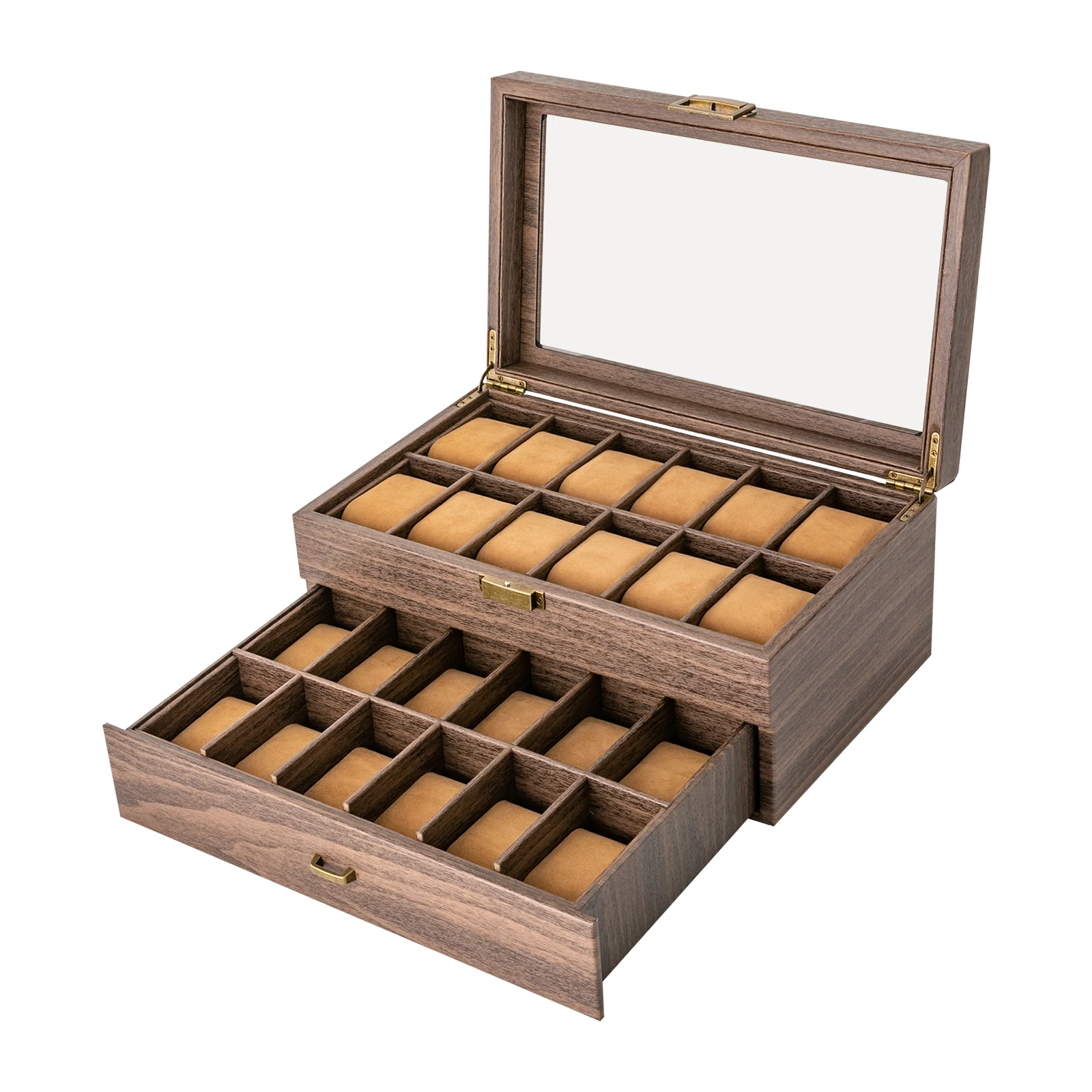
Aesthetic Comparison: Style and Presentation
The visual appeal of your watch box is undoubtedly an important consideration, as it will likely occupy a prominent place in your bedroom, office, or display area. Wood and leather offer distinctly different aesthetic experiences:
Wood embodies traditional elegance with natural warmth. The organic patterns of wood grain create visual interest and depth that manufactured materials cannot replicate. Each wooden box is subtly unique due to natural variation in grain patterns. This traditional material often complements classic watch styles, vintage collections, and traditional home décor. The substantial presence of a wooden box adds gravitas to your collection, signaling permanence and established taste.
In contrast, leather projects contemporary sophistication with tactile appeal. Its smooth or textured surfaces create a more modern impression that pairs beautifully with both classic and contemporary watches. The wider color range available in leather allows for more personalized expression and coordination with your interior design scheme. The sleek, often minimalist profile of leather boxes lends itself to modern spaces and design aesthetics.
How your watches appear when displayed differs significantly between materials. Wood creates a contrasting background that makes metal watch elements pop visually. The solid frame of wooden boxes with glass tops presents watches almost like museum pieces. Leather, on the other hand, creates a softer backdrop that lets watches stand out while adding texture to the presentation. The more flexible nature of leather sometimes allows for more innovative display angles and configurations.
Over time, both materials develop character in different ways. Wood deepens in color and develops a rich patina that speaks to its age and quality. Leather softens and often becomes more supple, developing unique wear patterns based on handling. Both materials tell a story of use and care that mass-produced synthetic alternatives cannot match.
For advice on integrating watch storage with home décor, consider how your watch box will interact with your existing furniture and design elements. The material choice should complement rather than clash with your personal space.
Maintenance Requirements: Caring for Your Watch Box
The long-term performance of your watch box depends significantly on proper maintenance. Wood and leather have different care requirements that should factor into your decision:
Wood Care Requirements:
- Regular dusting with a soft, dry cloth
- Occasional polishing with appropriate wood care products
- Avoiding direct sunlight to prevent color fading
- Maintaining moderate humidity levels (40-60%)
- Keeping away from heating vents and radiators
- Addressing spills immediately to prevent staining
- Periodic checking and tightening of hardware
Leather Care Requirements:
- Dusting with soft cloth or gentle vacuuming
- Regular conditioning with leather-specific products
- Keeping away from direct sunlight to prevent drying and fading
- Avoiding contact with oils, alcohols, and solvents
- Spot-cleaning stains with appropriate leather cleaners
- Storing in moderate humidity to prevent mold issues
- Allowing proper air circulation when not in use
Wood generally requires less frequent but more specialized maintenance. A quality wooden box with a good finish might need attention only a few times per year, but that maintenance often involves specific products designed for the particular finish type. Lacquered finishes are relatively low-maintenance, requiring only dusting and occasional polishing. Oil finishes might need more regular refreshing to maintain their protective qualities.
Leather typically needs more regular but simpler maintenance. Conditioning leather every few months helps prevent drying and cracking, especially in low-humidity environments. The type of leather significantly impacts maintenance needs—full-grain leather generally develops a desirable patina with minimal intervention, while finished leathers may require more specific care products to maintain their appearance.
Environmental factors play a crucial role in maintenance requirements for both materials. Extremely dry environments accelerate drying in both wood and leather, potentially leading to cracking. Excessive humidity can cause wood to swell or warp and may encourage mold growth on improperly treated leather.
For detailed guidance on proper care techniques for different materials, our maintenance guide for different materials provides specific recommendations to help preserve your watch box’s appearance and functionality for years to come.
Cost and Value Considerations
Price ranges for quality watch boxes vary widely based on materials, craftsmanship, features, and brand reputation. Understanding the general price landscape helps set realistic expectations:
Entry-level wooden watch boxes with basic construction and finishes typically start around $80-150 for designs holding 5-10 watches. Mid-range wooden options with better craftsmanship, premium wood types, and enhanced features generally fall in the $150-300 range. Premium wooden watch boxes featuring exotic woods, master craftsmanship, or special features like integrated watch winders can range from $300 to well over $1,000.
Leather watch boxes generally offer more accessible starting points. Basic leather options start around $50-120 for simple designs holding 3-6 watches. Mid-range leather boxes with better quality leather and enhanced interior features typically range from $120-250. Premium leather options featuring full-grain leather, luxury brand names, or specialized features can range from $250 to $800 or more.
Several key factors influence the price within each material category:
- Material quality – Premium wood species or top-grain leather command higher prices
- Construction methods – Hand-crafted joinery or detailed stitching increases cost
- Interior materials – Higher-grade suede, velvet, or other linings add to the price
- Additional features – Glass displays, locks, drawers, or watch winders increase complexity and cost
- Brand reputation – Established luxury brands command premium pricing
- Size and capacity – Larger boxes accommodating more watches generally cost more
From an investment perspective, quality watch boxes often retain their functionality and appeal for decades when properly maintained. Wooden boxes typically offer better long-term durability, potentially making them better value despite higher initial costs. However, leather options often provide excellent functionality at more moderate price points, making them attractive for collectors who may change storage preferences over time.
When considering value, it’s worth remembering that proper storage can help maintain the condition and value of your watch collection. A quality storage solution that effectively protects timepieces worth thousands of dollars represents a sound investment, even at premium price points. For collectors with diverse storage needs, our multiple capacity watch box options offer various configurations to accommodate growing collections.
Matching Your Watch Collection Needs
The ideal watch box depends not just on material preferences but also on the specific characteristics of your collection. Consider these factors when making your choice:
Collection Size and Growth: For smaller collections of 1-5 watches, compact options in either material work well. Growing collections benefit from modular solutions or larger boxes with multiple compartments. Serious collectors often develop a mix of storage solutions as their collection evolves.
Watch Types and Sizes: Different watches have different storage requirements. Large sports watches (over 42mm) need more spacious compartments, while slim dress watches can fit in more compact spaces. Watches on metal bracelets require different support than those on leather straps. Consider the diversity in your collection when evaluating interior configurations.
Movement Types: Automatic watches benefit from either regular wearing or watch winders when stored long-term. If your collection includes primarily automatics, you might consider boxes with integrated winders or space to add them later. Quartz watches have fewer storage complications but still benefit from proper organization.
Collection Value: Higher-value collections generally warrant greater investment in protective storage. While both wood and leather can provide adequate protection, wooden boxes often offer superior physical security for very valuable pieces through sturdier construction and sometimes locking mechanisms.
Display Preferences: If you enjoy viewing your collection without opening the box, glass-top designs (available in both wood and leather) offer convenient display. Some collectors prefer closed storage for security or dust prevention, while others prioritize visual access to their collection.
Usage Patterns: Frequent travelers should consider portability and travel-specific features. If you rotate watches daily, easy access becomes more important than for occasional wear. Some collectors maintain separate solutions for frequently worn pieces versus occasional rotation watches.
As you assess these factors, specific questions can help guide your decision:
– Do you prioritize display or protection?
– How frequently do you access different watches in your collection?
– Are you likely to transport your watches regularly?
– How consistent is your home environment in terms of temperature and humidity?
– Is your collection fairly stable or likely to grow significantly?
For personalized guidance based on these considerations, our selection guide for watch cases offers additional insights tailored to different collection types and collector needs.
Watch Accessories, Watch Holder
$94.51 Select options This product has multiple variants. The options may be chosen on the product pageLuxury Watch Boxes, Men's Watch Boxes, Single Watch Box
Price range: $903.35 through $980.97 Select options This product has multiple variants. The options may be chosen on the product pageSingle Watch Travel Case, Watch and Jewelry Box, Watch Roll Travel Case
Price range: $93.44 through $140.65 Select options This product has multiple variants. The options may be chosen on the product pageMen's Watch Organizer, Watch Display Case, Watch Organizer
Price range: $112.68 through $169.45 Select options This product has multiple variants. The options may be chosen on the product pageAutomatic Watch Winder, Luxury Watch Winder, Single Watch Box
$307.39 Select options This product has multiple variants. The options may be chosen on the product pageLuxury Watch Boxes, Luxury Watch Travel Case
Price range: $200.33 through $224.57 Select options This product has multiple variants. The options may be chosen on the product page
Travel and Portability Factors
For collectors who travel frequently with timepieces, portability becomes a crucial consideration in choosing the right watch storage solution. This is an area where material choice significantly impacts practicality.
Leather watch boxes offer clear advantages for travel purposes:
– Significantly lighter weight – Often weighing 50-70% less than comparable wooden boxes
– Greater flexibility – Can sometimes be compressed slightly to fit in packed luggage
– Less susceptibility to damage – Less likely to show scuffs from travel handling
– Often designed with travel in mind – May include secure clasps, reinforced corners, or handle options
Wood watch boxes, while excellent for home storage, present several challenges for frequent travelers:
– Heavier to transport – Can add substantial weight to carry-on or checked luggage
– More vulnerable to transit damage – May show scratches or dents from handling
– Less space-efficient – Typically bulkier due to rigid construction
– Potential for hardware issues – Hinges and clasps may loosen with frequent movement
For air travel specifically, watch boxes must balance protection with practicality. Leather travel cases often feature specialized designs with compressed profiles, secure closures, and sometimes zippered compartments that make them ideal for this purpose. Wooden boxes, unless specifically designed for travel, are generally better left at home.
Security checkpoints present another consideration. Watches in carry-on luggage typically need to be removed for screening. A compact, easily opened case facilitates this process while minimizing handling of the watches themselves. Some dedicated watch storage for frequent travelers includes features specifically designed to streamline this experience.
Many serious collectors eventually adopt a dual-solution approach: a substantial wooden box for home storage and display, complemented by a compact leather travel case for portable protection. This combination offers the best of both materials—the elegant presentation and superior protection of wood at home, with the lightweight practicality of leather while on the move.
Environmental and Ethical Considerations
As sustainability becomes increasingly important to consumers, the environmental impact of watch box materials warrants consideration. Both wood and leather raise specific environmental and ethical questions:
For wooden watch boxes, sustainability focuses primarily on harvesting practices. Responsibly sourced wood from managed forests represents a renewable resource with relatively low environmental impact. Look for certifications like FSC (Forest Stewardship Council) that verify sustainable forestry practices. Some manufacturers now specialize in reclaimed or salvaged wood options that minimize new resource consumption while often featuring distinctive character and grain patterns.
The finishing processes for wooden boxes also have environmental implications. Traditional solvent-based finishes emit VOCs (volatile organic compounds), while newer water-based finishes offer reduced environmental impact. Some boutique manufacturers now emphasize natural oil finishes that minimize chemical usage while providing adequate protection.
Leather production raises different ethical considerations. Traditional leather tanning uses significant resources and potentially harmful chemicals. For ethically conscious consumers, options include:
– Vegetable-tanned leather using plant-based tannins instead of chromium
– Leather sourced from food industry byproducts rather than dedicated production
– Certified leather meeting environmental and worker safety standards
– Vegan alternatives made from synthetic materials or plant derivatives
Synthetic alternatives have their own environmental considerations. While avoiding animal products, many synthetic leathers use petroleum-based materials with significant carbon footprints. However, newer bio-based alternatives derived from pineapple leaves, apple peels, or mushrooms offer promising eco-friendly options with leather-like properties.
End-of-life considerations also differ between materials. Quality wooden boxes can typically be refinished or repurposed multiple times, potentially lasting generations. While leather boxes may have shorter functional lifespans, many leather types are biodegradable, unlike synthetic alternatives that may persist in landfills.
For collectors seeking storage solutions that align with their values, our multi-purpose storage solutions include options with various sustainability credentials to meet different environmental priorities.
Making Your Decision: Key Questions to Ask
To determine the ideal watch box material for your specific needs, consider these guiding questions:
1. What is your primary storage goal?
– For maximum physical protection: Wood typically offers superior structural integrity
– For gentle, scratch-free storage: Leather provides naturally soft contact
– For display purposes: Either material works well, though wood often offers sturdier display options
– For travel or portability: Leather provides clear advantages in weight and flexibility
2. What is your home environment like?
– For very humid environments: Well-sealed wood with moisture-resistant finishes may perform better
– For very dry environments: Leather may require more frequent conditioning
– For varied temperatures: Wood provides better insulation against fluctuations
– For dusty environments: Boxes with excellent seals are crucial regardless of material
3. What type of watches do you collect?
– For vintage pieces: Wood often complements their traditional character
– For modern watches: Either material works well, with leather often matching contemporary design
– For very valuable pieces: Wood’s structural integrity may provide peace of mind
– For watches worn in rotation: Ease of access may be more important than material
4. What is your aesthetic preference?
– For traditional, classic spaces: Wood often integrates more seamlessly
– For contemporary, modern décor: Leather frequently complements these settings better
– For personalization: Leather offers more color options, wood offers more texture variations
– For visual impact: Consider which material better showcases your specific watches
5. What is your maintenance tolerance?
– For minimal intervention: Quality finished wood may require less frequent care
– For simple care routines: Leather typically needs more regular but straightforward conditioning
– For long-term durability: Properly maintained wood generally lasts longer
– For resistance to everyday handling: Leather often shows fewer fingerprints and minor marks
These questions help translate general material properties into specific recommendations based on your unique circumstances. Remember that there’s no universally “best” material—only the right choice for your particular collection, environment, and preferences.
As you evaluate options, exploring display options for watch collections can provide visual references for how different materials showcase timepieces.
Watch Box Features Beyond Material
While material choice is fundamental, several other features significantly impact a watch box’s functionality and value:
Closure Mechanisms enhance security and dust protection. Options range from simple magnetic closures to sophisticated push-button releases and traditional lock-and-key systems. Quality hardware that operates smoothly indicates attention to detail in construction.
Display Options vary widely across both materials. Glass or clear viewing tops allow appreciation of your collection without opening the box. Some designs feature angled display configurations that present watches at optimal viewing angles. Display quality considerations include clarity, reflectivity, and security of the viewing panel.
Interior Customization options accommodate different collection needs. Removable dividers allow reconfiguration as your collection evolves. Adjustable cushions accommodate watches of different sizes. Some premium boxes feature modular designs that can be expanded with additional sections over time.
Integrated Storage for accessories adds functionality. Dedicated compartments for tools, spring bars, extra straps, or small parts keep watch-related items organized. Some boxes include hidden drawers beneath the main watch compartments for valuable documents or additional accessories.
Watch Winder Integration becomes important for automatic watch collections. Some boxes incorporate powered winding modules to keep automatic watches running when not worn. These range from simple single-winder systems to sophisticated programmable units with directional control and timing options.
Travel Features may include reinforced corners, water-resistant exteriors, secure clasps, and compact designs. Specialized travel cases often incorporate cushioned protection and secure watch retention systems to prevent movement during transport.
Humidity Control options help protect watches in challenging environments. These range from simple silica gel packets to integrated hygrometers or even active humidity regulation systems in premium boxes.
The quality of these features often matters more than whether the box is made from wood or leather. A thoughtfully designed box with excellent interior protection and useful features provides better value than one that emphasizes material quality while overlooking functional details.
For collectors with specific display priorities, our watch display solutions showcase various configurations that highlight timepieces effectively regardless of exterior material.
Wood and Leather Hybrid Options
For collectors who appreciate aspects of both materials, hybrid watch boxes offer intriguing alternatives that combine the strengths of wood and leather. These thoughtfully designed options merge structural integrity with aesthetic versatility.
Common hybrid configurations include wooden frames with leather wrapping or inlays. This construction method provides the solid protection of a wooden structure while adding the soft touch and visual appeal of leather accents. The wood core ensures excellent structural integrity, while the leather exterior offers a sophisticated appearance with greater color options.
Another popular hybrid approach features wooden boxes with leather interior components. These designs combine the protective qualities and display capabilities of wood with the gentle watch contact of leather-lined compartments and cushions. The rigid wooden exterior provides excellent dust protection and display stability, while the leather interior elements cradle watches securely.
Some premium designs incorporate leather-wrapped lids on wooden bases. This combination offers the substantial presence and stability of a wooden foundation with the sophisticated appearance of a leather-covered lid. These designs often feature contrast stitching or decorative elements that highlight the leather craftsmanship while maintaining wood’s structural benefits.
Hybrid options generally address the limitations of single-material choices. The wood components provide the structural integrity that pure leather boxes sometimes lack, while the leather elements add a tactile quality and design flexibility not possible with wood alone. For example, a wooden box with a leather-wrapped exterior offers better impact protection than an all-leather design while providing more color options than natural wood.
These sophisticated combinations typically position themselves in the premium market segment. The combination of quality materials and more complex construction generally results in higher price points, but the versatility and aesthetic appeal often justify the investment for discerning collectors.
For those interested in versatile storage solutions that incorporate multiple materials and functions, our versatile watch storage options include hybrid designs that beautifully bridge traditional and contemporary approaches.
Storage Environment Considerations
The environment where you store your watches significantly impacts which material might perform better for your specific situation. Both wood and leather respond differently to environmental factors:
Humidity Factors:
– In high-humidity environments (over 60%), wood may absorb moisture and potentially swell or warp if not properly sealed or finished
– In very dry conditions (below 30% humidity), leather can dry out and crack without regular conditioning
– Wood generally performs better in moderate humidity with minimal fluctuations
– Leather with proper treatment can tolerate somewhat wider humidity variations
Temperature Considerations:
– Extreme temperature fluctuations affect both materials but in different ways
– Wood provides better insulation, creating more stable internal temperatures
– Leather transmits external temperature changes more quickly to the interior
– Neither material should be stored near direct heat sources or in freezing conditions
– Wood generally maintains more consistent internal conditions during seasonal changes
Light Exposure:
– Both materials can fade with prolonged UV exposure
– Leather typically shows color changes more quickly than finished wood
– Glass-topped boxes should be positioned away from direct sunlight regardless of material
– Wood with oil finishes may need more protection from light than lacquered finishes
– UV-protected glass tops offer additional protection for displayed watches
Air Quality:
– In dusty environments, the sealing quality of the box becomes more important than the material itself
– Areas with strong odors may affect leather more noticeably than sealed wood
– Regions with high pollution levels may require more frequent cleaning of exterior surfaces
– Wood with quality finishes generally resists environmental contaminants better
Regional climate considerations should inform your choice. Coastal areas with high humidity and salt air might favor well-sealed wooden boxes with moisture-resistant finishes. Dry desert climates might require more maintenance for leather but could also cause issues for wooden boxes without proper humidification. Seasonal climate changes affect both materials but can be mitigated with proper indoor climate control.
For detailed guidance on material selection based on environmental factors, our materials and construction guide provides specific recommendations tailored to different climates and storage conditions.
Is Wood or Leather Better for Valuable Watch Collections?
Collectors with valuable timepieces often have heightened concerns about protection and security. Both materials can adequately protect premium watches when properly designed, but they offer different advantages:
For physical security, wooden boxes generally provide superior protection. Their rigid construction creates a more substantial barrier against accidental damage. Premium wooden boxes often feature lock mechanisms, from basic key locks to more sophisticated systems, adding a layer of security for valuable collections. The weight and solidity of wooden boxes also make them less likely to be casually moved or misplaced.
For protection against environmental factors, the comparison is more nuanced. Quality wooden boxes typically offer better insulation against temperature changes, which can be important for mechanical watch accuracy. However, well-designed leather boxes with proper interior construction can provide excellent dust protection and adequate environmental buffering for most situations.
From an insurance perspective, secure storage demonstrates proper care of valuable assets. Some insurance policies for high-value collections specifically require locked storage. In these cases, wooden boxes with quality locking mechanisms might better satisfy insurance requirements, though specialized watch safes represent the ultimate security solution for extremely valuable collections.
For long-term investment protection, both materials can perform well when properly maintained. The critical factor becomes the quality of construction and interior design rather than the exterior material itself. Features like individually padded compartments, secure cushions that prevent movement, and protection against watch-to-watch contact matter more than whether the exterior is wood or leather.
The display aspect becomes particularly important for investment-grade watches, where occasional appreciation without handling helps minimize wear. Glass-topped displays in either material allow visual enjoyment while maintaining a protected environment. Wood often provides more stable display platforms, while leather can offer sleeker, more contemporary presentation.
For comprehensive guidance on storing valuable collections, our comprehensive storage planning resources address security considerations alongside aesthetic and practical factors, helping collectors make informed decisions based on their specific collection value and characteristics.
Final Thoughts: Making Your Selection
After exploring the various aspects of wood and leather watch boxes, your final decision should reflect your personal priorities, collection needs, and aesthetic preferences. Both materials offer excellent storage options when well-designed and properly maintained.
Wood watch boxes excel in providing substantial protection with traditional elegance. Their solid construction offers superior impact resistance and structural integrity, making them ideal for home storage where protection and display are primary concerns. The timeless appeal of quality hardwood complements both vintage and contemporary watch collections while offering excellent long-term durability.
Leather watch boxes shine in combining sophisticated style with practical portability. Their lighter weight and flexible designs make them particularly suitable for collectors who travel with timepieces or prefer sleeker, more contemporary storage solutions. The tactile quality and color variety of leather allow for more personalized expression and easier integration with modern interiors.
Rather than viewing this as a binary choice, many serious collectors eventually incorporate both materials into their storage strategy. A primary wooden display box for home use paired with a leather travel case often represents the ideal combination, leveraging the strengths of each material for different scenarios.
Regardless of material, quality indicators remain consistent. Look for precise construction, thoughtful interior design, smooth-operating hardware, and attention to detail in finishing. The protection of your watches ultimately depends more on these factors than on the exterior material itself.
As your collection evolves, your storage needs may change as well. Starting with quality pieces that reflect your current requirements while allowing for future growth ensures that your storage solution enhances rather than limits your collecting experience. Whether you choose the classic stability of wood or the flexible sophistication of leather, the right watch box becomes not just a storage tool but an extension of your appreciation for fine craftsmanship.

